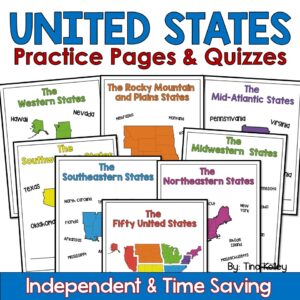Teaching the 50 states and capitals can seem overwhelming, but with the right plan and some engaging activities, it can become one of the most rewarding lessons of the year. In this blog post, I’ll outline my flexible, week-by-week approach to ensure your children master U.S. geography while having fun along the way.
Why Teach the 50 States and Capitals?
Teaching the 50 states and capitals plays a vital role in helping children understand the geography and structure of the United States. It fosters a sense of national pride and curiosity about each state’s unique aspects. By learning the capitals, state locations, and regional characteristics, students gain a foundational awareness that connects history, economics, and culture. This knowledge enhances critical thinking and prepares students for more advanced studies in civics and social sciences.
Step One: Start With a Managable Region
When introducing the 50 states and capitals, begin with a smaller region of the U.S. that feels achievable for your children. For example, the Southwestern states—Texas, New Mexico, Arizona, and Oklahoma—are a great starting point. Or try the states that border the state you live in. Tackling fewer states at a time builds confidence and sets the stage for success.
Step Two: Gather Your Materials
To set your children and you up for success, Gather interactive and repetitive materials to help build memorization and attention skills.
Here are some tools I recommend using:
Printable state-focused activities: These provide a structured way for students to practice writing state names, capitals, and postal abbreviations.
Coloring maps: Let students color and label maps to add a creative, interactive element to the lesson.
Practice sheets: Repetition through handwriting practice reinforces spelling and recognition.
If you’re looking for ready-to-use resources that save you time, my “50 States and Capitals” activities include everything you need to easily implement this step. These materials are designed to support both independent and guided practice, making learning the 50 States and Capitals more effective and stress-free.
Step Three: Make Learning Memorable with Fun Facts
Adding context to each state helps your child remember the state names, capitals, and provides a bit of fun. Encourage them to research fun facts or historical landmarks for each state. Some examples include:
Texas: The Alamo—a key historical site.
New Mexico: Fort Selden, home of the Buffalo Soldiers.
Arizona: The Grand Canyon, one of the Seven Natural Wonders of the World.
Oklahoma: Fort Towson, rich in frontier history.
Let your child explore additional topics like famous foods, crops, or cultural traditions. This creates a connection between the state and their daily lives.
Step Four: Reinforce the Learning With Games and Flashcards
Interactive activities are key to keeping your child engaged as they memorize the 50 states and capitals. Here are a few ideas:
Memory Match: Match states with their capitals or postal abbreviations.
Speed Quiz: Time your child as they identify states and capitals. Have them try to beat you or themselves.
Puzzles: Have a wooden puzzle on hand for your child to take apart and put back together. Hands-on activities provide a kinesthetic aspect to learning.
State Trivia: Turn review time into a lively family competition.
Digital Games: Independent practice on the computer is always fun. Here are some digital practice games that are not public.
These activities encourage repetition in a way that feels like play, helping students retain information more effectively.
Step Five: Get Creative
Take advantage of a variety of resources to make memorization fun:
Songs and Bingo: Use U.S. geography songs and bingo cards for engaging practice sessions.
Digital Resources: Websites like Sheppard Software and National Geographic offer interactive games to reinforce knowledge (ensure content aligns with your classroom’s needs).
Educational Apps: Try apps like Stack the States or BrainPOP for technology-based learning.
Hands-On Activities: Use puzzles, word searches, or create custom memory games to enhance learning.
Step Six: Assess Your Child's Progress and Celebrate Success
Once your child feels confident, assess their skills.
- Start by assessing the small regions into which you have broken the states. This helps to get your child comfortable with an assessment and build their confidence.
- Use assessments to evaluate their ability to spell state names, recall capitals, and label maps accurately.
Celebrate their achievements with certificates, stickers, or a class party. Acknowledge milestones to keep your child motivated.
After mastering one region, move on to the next, gradually building toward all 50 states and capitals.
Ideas to Expand the Teaching of the 50 States and Capitals
Here are some additional ways to make learning the 50 states and capitals more exciting:
Postcard Exchange: Partner with other homeschoolers across the U.S. to exchange postcards, giving children a personal connection to each state.
State Cuisine Day: Find recipes from different states, such as Louisiana’s Gumbo or Hawaii’s Spam Musubi, for a delicious geography lesson.
State Projects: Assign students a state to research and present, complete with drawings and fun facts. Here is a simple one.
Virtual Field Trips: Explore national landmarks and museums through online tours.
Collaborative U.S. Map: Hang a large map where family members add state facts, symbols, and landmarks as they master each region.
Suggested Timeline for Teaching the 50 States and Capitals
In a typical classroom setting, I would spend about one week per region, reserving two weeks at the end for review and mastery of all 50 states and capitals. With this schedule, most children can confidently learn all 50 states and capitals in 8-10 weeks. However, please adjust the timeline as needed to suit your child’s pace and interests.
Final Thoughts
Teaching the 50 states and capitals doesn’t have to be overwhelming. By breaking the process into manageable steps, incorporating creative activities, and celebrating successes, you can make this unit both educational and enjoyable. Adapt these strategies to meet your child’s needs, and watch your child grow in confidence and knowledge!
If you have tips or ideas for teaching the 50 states and capitals, share them in the comments below. Let’s collaborate to make U.S. geography a highlight of the school year!
Want more tips? Check my other Blog post: 7 Fun Ways to Teach the 50 States and Capitals.
If you need a ready-to-go unit for teaching the 50 States and Capitals, check out the one I used successfully for over 15 years in my classroom. Updated specifically for homeschoolers, this comprehensive resource is designed to make planning easy and learning effective. Take a look at it here.





